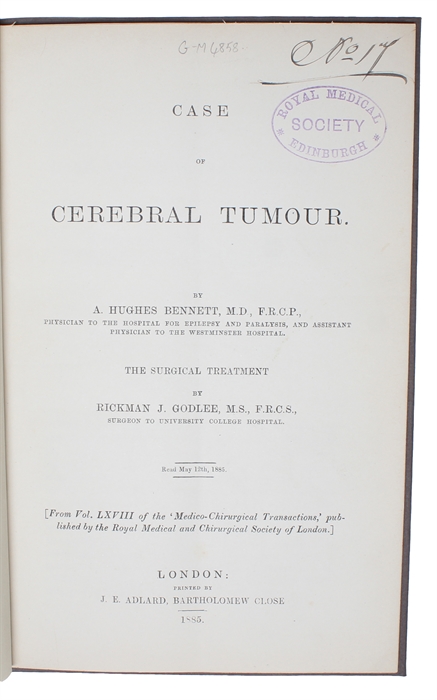FIRST REMOVAL OF A BRAIN TUMOR
BENNETT, A. HUGHES & RICKMAN J. GODLEE.
Case of Cerebral Tumor. Read May 12th, 1885. [Offprint from "Medico-Chirurgical Transactions", Vol. 68].
London, 1885.
8vo. Bound in a recent grey paper binding with printed paper label to front board. Old library stamp on the title-page (Royal Medical Society Edinburgh). A faint vertical crease down the middle of the block. A nice and sound copy. (2), 33 pp. Illustrated.
Extremely scarce privately printed offprint, done by the authors themselves, of this landmark work, which led to the advent of modern neurosurgery, namely the original report on the first primary brain-tumor operation.
""The 25th of November 1884 is to be remembered as an historical date in the annals of surgery for it was upon this day that a brain tumor was first removed by surgery...." These were the words of Edwin Bramwell... References have often been made to this important surgical achievement by Dr. Rickman Godlee but of truly historical impact was the successful diagnosis and localization of the tumor based on neurological findings alone by the physician in charge of the case, Alexander Hughes Bennett. Together, Bennett and Godlee presented their report on A Case of Cerebral Tumor before the Royal Society of Medicine on May 12, 1885." (From "Classics in Oncology" in: A Cancer Journal for Clinicians, Volume 24, Issue 3).
Before this landmark operation that came to shape the future of neurosurgery, all previously recorded intracranial surgery depended on external evidence of injury. This, however, was to change with the publication of the present paper.
"Some prominent surgical personalities of the nineteenth century led to some major advances in surgical technology, particularly in neurosurgery. Until the end of the nineteenth century, neurosurgery was not a subspeciality; general surgeons, typically with a large top hat, bewhiskered, and always pontifical, performed brain surgery!
Sir Rickman Godlee (1859-1925) removed one of the most celebrated brain tumors, the first to be successfully diagnosed by cerebral localization, in 1884. The patient, a man, by the name of Henderson, had suffered for 3 years from focal motor seizures...
A neurologist, Alexander Hughes Bennett (1848-1901), basing his conclusions on the findings of a neurological examination, localized a brain tumor and recommended removal to the surgeon. Godlee made an incision over the rolandic area and removed the tumor through a small cortical incision. The patient survived the surgery with some mild weakness and did well, only to die a month later from infection. Bennett, the physician who made the diagnosis and localization, along with J. Hughlings Jackson and David Ferrier, two prominent British neurologists, observed this landmark operation. All of these physicians were extremely interested in whether the cerebral localization studies would provide necessary results in the operating theater. The results were good; this operation remains a landmark in the progress of neurosurgery." (Richard G. Ellenbogen, Saleem I. Abdulrauf, Laligam N Sekhar: Principles of Neurological Surgery, p. 3).
"On November 25, 1884, Mr. Rickman J. Godlee performed the first recognized resection of a primary brain tumor. This operation was carried out at the suggestion of Dr. A. Hughes Bennett, a neurologist at The Hospital for Epilepsy and Paralysis, Regents Park, London, England. Other operations for intracranial tumor had been performed but were for extracerebral meningeal or osseous tumors. The "first" operation for a primary cerebral tumor by Godlee was meticulously described and well documented in the medical and popular press of the day and stimulated both professional and lay discussions of the topic that directly and indirectly led to further surgery on the cerebrum itself and the advent of modern neurosurgery. The original patient of Mr. Godlee died on the 28th postoperative day of apparent meningitis and secondary complications, but postmortem examination revealed no remnant of the excised glioma...
Godlee was the first to remove an intracranial brain tumor of cancerous origin and deserves historical recognition in his own right." (Kirkpatrick, 1984).
A short, unillustrated, preliminary report was published in the Lancet.
G&M: 4858.
Order-nr.: 54947


![Case of Cerebral Tumor. Read May 12th, 1885. [Offprint from "Medico-Chirurgical Transactions", Vol. 68].](/images/product/54947b.jpg)
![Case of Cerebral Tumor. Read May 12th, 1885. [Offprint from "Medico-Chirurgical Transactions", Vol. 68].](/images/product/54947c.jpg)
![Case of Cerebral Tumor. Read May 12th, 1885. [Offprint from "Medico-Chirurgical Transactions", Vol. 68].](/images/product/54947d.jpg)